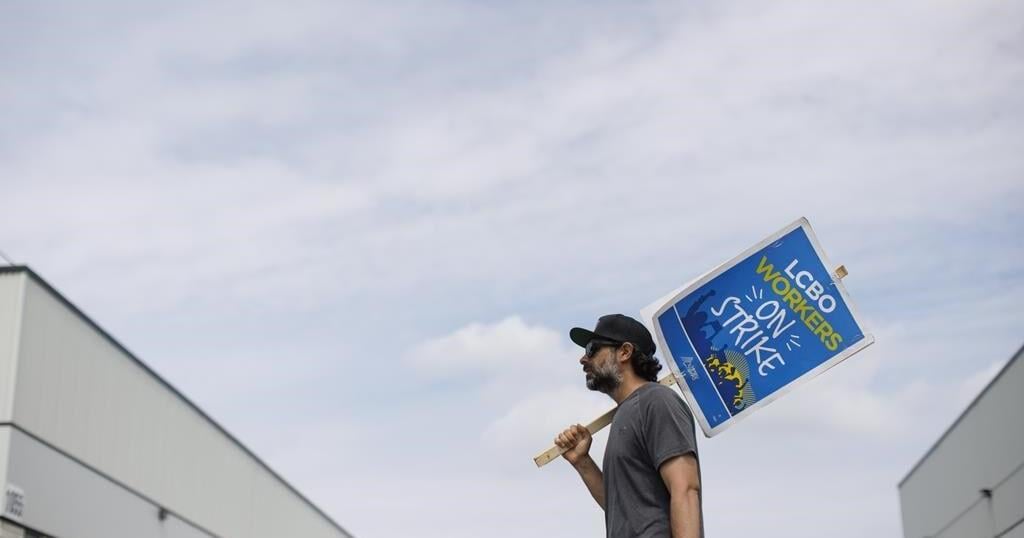MISSISSAUGA, Ont. – The union representing Ontario liquor store workers has ramped up pressure in a five-day-old strike, with no talks planned to hammer out a deal.
Thousands of workers at the Liquor Control Board of Ontario walked off the job Friday. The LCBO, in turn, shuttered its stores across the province for two weeks.
At an LCBO distribution centre in Mississauga, Ont., several dozen workers on the picket line delayed delivery trucks entering the warehouse on Tuesday.
“We are slowing the flow of vehicles in and out of the LCBO facility on this property so that their ability to get orders out is reduced,” said Patricia Roode, a customs clerk in the LCBO’s transportation division.
Similar actions by the Ontario Public Service Employees Union are playing out at other distribution centres, Roode said.
The LCBO has brought in scab workers in an attempt to fulfil warehouse orders, she said.
The Crown corporation had intended to open five distribution centres this week to help get booze into restaurants, bars, hotels, convention centres and other licensees across the province.
The LCBO now says that will not happen due to picketing at the locations and it will instead offer online ordering for smaller orders.
“In light of OPSEU threats to picket these locations, we have made the decision to offer an alternative online experience for smaller orders,” the LCBO wrote in a statement.
The union believes Premier Doug Ford’s plan to open up the alcohol sales market poses an existential threat to the LCBO that will lead to major job losses.
It does not want ready-to-drink cocktails sold outside LCBO stores, wants the province to guarantee its jobs, as well as wage increases, and wants more permanent rather than part-time positions.
Finance Minister Peter Bethlenfalvy has said the government is “more committed than ever” to its alcohol expansion plans in order to give Ontarians more choice and convenience.
The LCBO has said its last contract offer included wage increases and converting several hundred part-time jobs to full-time positions.
“The LCBO did not want a strike, and we apologize for the inconvenience to our wholesale customers,” the Crown corporation said.
The union has said the sticking point is Ford’s policy to open up alcohol sales, which OPSEU wants changed.
The first step of the expansion plan is set to start in less than a month, when grocery stores that already sell beer and wine will be able to sell ready-to-drink cocktails. Convenience stores can start selling beer, wine, cider and ready-to-drink cocktails on Sept. 5.
Nearly 3,000 convenience stores have already signed up to sell alcohol.
“We want it to be slowed down or done in a way that maintains the benefit to the people of Ontario rather than throwing money out the window,” Roode, the striking LCBO worker, said.
The province said it does not want to privatize the LCBO, rather the expansion is about giving people more choice and more convenience to buy alcohol. Ford has said it is time “to treat people like adults.”
The LCBO is a cash cow for the province, netting some $2.5 billion in 2022-23, or about $159 per person.
“LCBO revenue and the dividends paid to the government have continued to grow, even as successive governments have expanded alcohol sales to new retail stores and allowed bars and restaurants to sell alcohol with takeout and delivery,” Bethlenfalvy said in a letter to the LCBO on Tuesday.
“The evidence is clear: you can provide more choice while still generating revenue to invest in front-line government services.”
Bethlenfalvy was writing to Carmine Nigro, the chairman of the board of the LCBO, directing the Crown corporation to showcase and promote Ontario beer, wine, spirits and ciders as part of the expansion.
The union’s president said the government is not open to discussing changes to its alcohol expansion plans.
“We want to be part of the expansion and we want the premier and the LCBO to come back to the table and talk about how we can protect good jobs in all of our communities and protect this resource that funds everything that we hold dear in Ontario,” said OPSEU’s J.P. Hornick.
On Monday, Premier Doug Ford released a video with an interactive map designed to show people where they can buy booze outside the LCBO.
Meanwhile, the LCBO’s online system to sell alcohol during the strike has hit a snag.
“There are challenges with the online ordering system, but the LCBO is aware and are working to correct it,” said Kris Barnier, a vice-president at Restaurants Canada.
“The top products have been challenging to get.”
Otherwise, restaurants and bars in Ontario are holding up so far amid the strike, although Barnier admits it is tense times right now.
“We’ll see how it goes if the strike goes on much longer,” he said.
The LCBO said it is aware of the issue and is making “every effort” so customers can find what they want online.
“We have planned for an increase in inventory and ask for customers’ patience as we continue to stock up on favourite items,” it said.
This report by The Canadian Press was first published July 9, 2024.

























